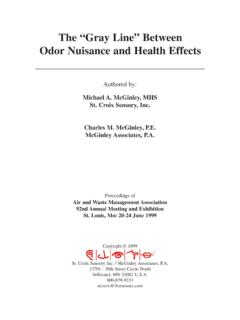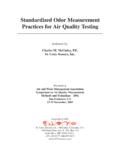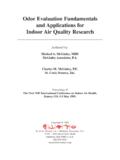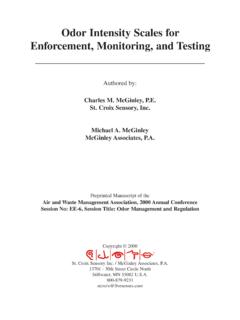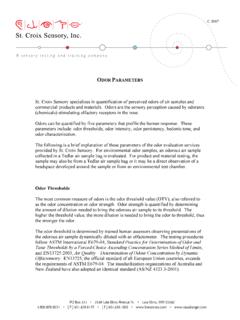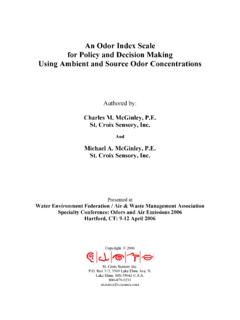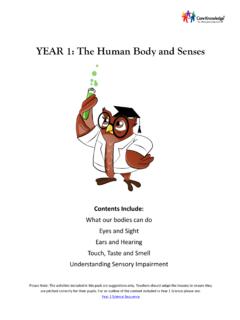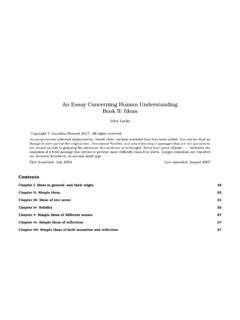Transcription of 'Odor Basics', Understanding and Using Odor Testing
1 Odor Basics , Understanding and Using Odor TestingAuthored by:Charles M. McGinley, Croix Sensory, A. McGinley, MHSSt. Croix Sensory, L. McGinleySt. Croix Sensory, atThe 22ndAnnual Hawaii Water Environment Association ConferenceHonolulu, Hawaii: 6-7 June 2000St. Croix Sensory Inc. / McGinley Associates, - 30th Street Circle NorthStillwater, MN 55082 2000 ABSTRACTOf the five senses , odor is the most evocative and least understood. Odor Testing seemsmysterious and odor data mythical to most practitioners. In millennium past the "practice ofodor" was in the hands of wizards, magicians, and experts. For years engineers and operatorshave relied on odor experts to interpret odor Testing results. Today odor, odor control, andodor nuisance are understandable subjects for plant operators, facility managers, engineeringpractitioners, and most frequently asked questions of odor Testing :1.
2 What is an odor unit ?2. Where does the result come from?3. How accurate is the result?4. Are there Testing standards?5. Aren t the odor results subjective?Odor is measurable and quantifiable Using standard practices as published by the AmericanSociety of Testing and Materials (ASTM E679 and E544) and by the European Union. In 2000the proposed European Normalization Standard, prEN 13725, will be implemented and becomethe de facto "International Standard" for odor/odour , odor Testing is overlooked as a valuable tool for engineering and paper presents the "diary" of one odor sample from the sampled source through the odorlaboratory. The data from the odor laboratory will also be viewed from the engineer's or facilitymanager's perspective for use in decision making at the , odour, olfactomatics, olfactometry, olfactometer, Testing , sensory, olfactory1 INTRODUCTIONC ommunity odors remain one of the top three complaints to air quality regulators andgovernment bodies around the and internationally.
3 The majority of all air pollutioncomplaints are odor from a facility, such as a wastewater treatment plant, can affect the community. Theseodors commonly lead to nuisance complaints. Estimating the effects of odors from a facilityoften requires laboratory odor Testing . In order to accomplish this Testing , air samples from thefacility are collected and shipped overnight to an odor- Testing laboratory. Engineers andmanagers can use the odor test results to help in their decision Testing in the laboratory is conducted to quantify an odorous air sample in terms of humanperception. During normal breathing, chemical molecules in the air pass by the olfactoryreceptors in the top, back of the nasal cavity. The olfactory nerves signal the brain and create apsychophysical response. For the general population the olfactory response to odors is normallydistributed.
4 Therefore, a representative group of the population is called an odor panel (odorassessors).The statistical concepts that are used for odor Testing are accepted internationally. The statisticalconcepts are known as the "forced-choice method" and the "ascending concentration seriesmethod". These methods are used when presenting a dilute odor sample to odor panelists fordetermining detection and recognition thresholds. The device used to present the dilute odorsample to odor panelists is called an "olfactometer".MAKING SENSE OF SMELLOf the five senses , the sense of smell is the most complex and unique in structure andorganization. While human olfaction supplies 80% of flavor sensations during eating, theolfactory system plays a major role as a defense mechanism by creating an aversion response tomalodors and irritants. This is accomplished with two main nerves.
5 The olfactory nerve (firstcranial nerve) processes the perception of chemical odorants. The trigeminal nerve (fifth cranialnerve) processes the irritation or pungency of a chemical normal nose breathing only 10% of inhaled air passes up and under the olfactoryreceptors in the top, back of the nasal cavity. When a sniffing action is produced, either aninvoluntary sniff reflex or a voluntary sniff, more than 20% of inhaled air is carried to the areanear the olfactory receptors due to turbulent action in front of the turbinates. These receptors areten to twenty-five million olfactory cells making up the olfactory epithelium. Cilia on thesurface of this epithelium have a receptor contact surface area of approximately five squarecentimeters due to the presence of many microvilli on their surface. Supporting cellssurrounding these cilia secrete mucus, which acts as a trap for chemical odorants pass by the olfactory epithelium and are dissolved (transferred) into themucus at a rate dependent on their water solubility and other mass transfer factors.
6 The morewater-soluble the chemical, the more easily it is dissolved into the mucus layer. A matching site on the olfactory cells then receives the chemical odorant. The response created by thereception of a chemical odorant depends on the mass concentration or the number of moleculespresent. Each reception creates an electrical response in the olfactory nerves. A summation ofthese electrical signals leads to an action potential. If this action potential has high enoughamplitude (a threshold potential), then the signal is propagated along the nerve, through theethmoidal bone between the nasal cavity and the brain compartment where it synapses with theolfactory olfactory signals meet in the olfactory bulb where the information is distributed to twodifferent parts of the brain. One major pathway of information is to the limbic system whichprocesses emotion and memory response of the body.
7 This area also influences the signals of thehypothalamus and the pituitary gland, the two main hormone control centers of the human second major information pathway is to the frontal cortex. This is where conscioussensations take place as information is processed with other sensations and is compared withcumulative life experiences for the individual to possibly recognize the odor and make somedecision about the experience. The entire trip from the nostril to the signal in the brain takes aslittle as 500 best analogy to understand what is happening with odor perception in the olfactory system isthat the receptor nerves are like keys on a piano. As a chemical odorant hits the pianokeyboard a tone is played. When multiple chemical odorants are present the result is a cord orspecific perception. For example, if keys 1, 3, and 7 are hit , then the brain perceives banana.
8 Likewise, if keys 4, 6, and 12 are hit , then the brain perceives sewer. The greater thenumber of odorant molecules present (higher concentration), the louder the cord is played. Theloudness of the cord is analogous to the intensity of the odor perception [McGinley, 1999].Odor is a Psychophysical PhenomenonPsychophysics involves the response of an organism to changes in the environment perceived bythe five senses [Stevens 1960]. Some examples include how the human body perceives soundloudness, lighting brightness, or odor psychophysical phenomena lead to sensory responses, which follow a power law. Apparent odor strength grows as a power function of the stimulus S. Stevens showed that this power law (Steven s Law) follows the equation:I = k CnWhere I is the odor intensity (strength), C is the mass concentration of odorant ( meter, mg/m3), and k and n are constants that are different for every odorant[Stevens 1962].
9 As shown in Figure 1, this equation is a straight line,plotted on a log-log ODOR SAMPLES ample No. 101 is an odorous air sample collected from the exhaust fan of the pretreatmentbuilding scrubber at a wastewater treatment facility. The pretreatment building at the facilityhouses the screening and grit removal processes. The building scrubber has a roof top exhaustfan that discharges upward through a short stack attached to the fan. Make-up air to the buildingenters through a makeup air system that can preheat the incoming air. However, makeup air alsoenters through opened doors and odor Testing is part of an odor study at the wastewater treatment facility. The purpose of theOdor Study is to compare odors from various processes at the facility. Therefore, the Study'sprotocol requires a sample of exhaust air from the pretreatment building scrubber under "normal"operating conditions.
10 The planners of the study must determine if "normal" operating conditionsexist with the doors and windows open or closed. The person doing the sampling mustdocument the conditions of the building (doors and windows) and the processes within thebuilding at the time of sampling. The conditions at the time of collecting Sample No. 101 mustbe documented so that the results will be in context to the Study's to the sample taking, the Sampler gathers together the needed sampling equipment:1. Ladder,2. Pliers or wrench to open the sample port;3. Pitot tube/inclined manometer to measure velocity and pressure in the stack;4. Thermometers (wet and dry bulb) to measure temperature of the exhaust air;5. 10-liter Tedlar gas sample bag with label;6. Vacuum case with vacuum pump;7. Teflon sample line (from exhaust stack to vacuum case);8.
